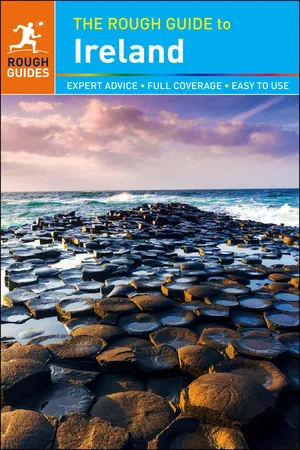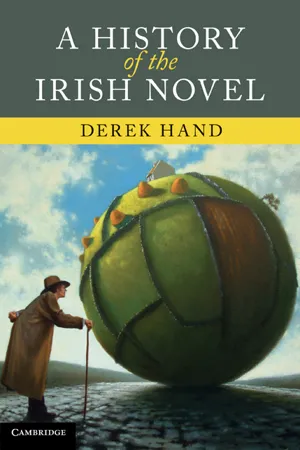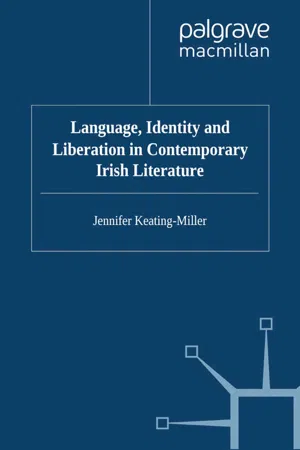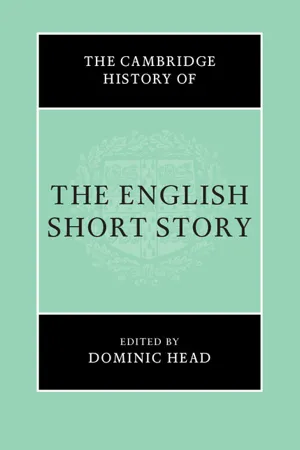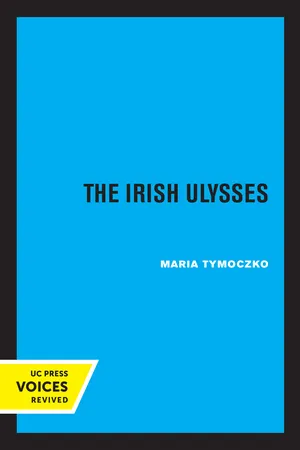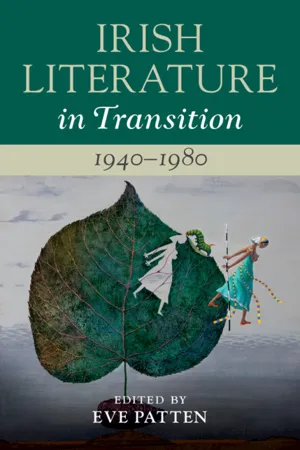Literature
Irish Literature
Irish literature encompasses the written and oral traditions of Ireland, including works in both English and Irish Gaelic. It reflects the rich cultural and historical heritage of Ireland, often exploring themes such as identity, politics, and the natural landscape. From ancient sagas and folklore to modern novels and poetry, Irish literature has made significant contributions to world literature.
Written by Perlego with AI-assistance
Related key terms
1 of 5
6 Key excerpts on "Irish Literature"
- eBook - PDF
- (Author)
- 0(Publication Date)
- Rough Guides(Publisher)
605 LITERATURE CONTEXTS Literature For an island of fewer than six million people, Ireland has an astonishingly rich literary tradition , the oldest in Europe outside of Italy and Greece. While most of this literature up to the seventeenth century was written in Gaelic (usually called Irish in Ireland today), and to a lesser extent Latin, English would become pre-eminent from the eighteenth century onwards and is today the first language not just of most Irish writing but also of the vast majority of Irish people. Ireland’s literary tradition has developed over two thousand years from the first markings on rocks around the time of Christ, to the acclaimed poetry, prose and theatre of writers such as W.B. Yeats, James Joyce and Samuel Beckett, producing startling works of originality and influence. Beginnings The oldest writing in Ireland was ogham script, a system of parallel notches that survives on standing stones from the fourth century AD, but was likely in existence for several hundred years previous. However, it was the arrival of Christianity in the fifth century that would have the most significant early influence on the emergence of literature in Ireland. With the growth of the monasteries between the seventh and tenth centuries, a rich culture of Latin manuscripts developed, the finest surviving example of which is the Book of Kells in Trinity College, Dublin (see p.59). During the same period, a thriving literary culture in the vernacular of Irish life, Gaelic, began to emerge and develop, too. While the oldest surviving manuscripts in this language date from around the twelfth century, much of the material was copied and recopied for many hundreds of years before that. The oldest datable work of Gaelic literature is Amra Choluim Chille (Elegy of St Columba), a poem attributed to the poet Dallán Forgaill and written soon after the death in 597 of one of Ireland’s most famous early saints, Colmcille, regarded as the patron saint of Irish poets. - eBook - PDF
- Derek Hand(Author)
- 2011(Publication Date)
- Cambridge University Press(Publisher)
That many of these writers (such as Joyce and Edgeworth) produced works that seem to test, stretch and break the boundaries of what a novel is thought to be – in fact, might be thought as not being novels at all – means the impression still lingers that the novel is singularly unsuited to the task of rendering the Irish world and Irish experience. Within this context, this history of the Irish novel is a history of the struggle towards articulation, of making the novel form express Irish stories and Irish concerns. It is also a history of developing Irish identities, of misrepresentations and the effort by writers to offer something genuinely authentic and complicatedly real. The novel – its sheer size – allows for the bringing together of difference in terms of native and visitor, Gaelic and Anglo-Irish, Catholic and Protestant, aristocrat and peasant. Thus the pages of the Irish novel are where issues concerning identity are played out repeat- edly. Ireland’s colonial relationship to Britain is obviously figured in this confrontation between differing identities and differing loyalties. It will be possible, in addition, to reflect on Irish culture’s developing relationship not only to Britain but also to Europe, America and the wider world in the contemporary moment of globalisation. A history of the Irish novel is a history of power and authority, a history of questions concerning colonial and native narratives, and of questions surrounding who speaks and writes and who is spoken and written about. A gradual movement from exclusively Anglo-Irish authors up to the nineteenth century, to the emergence of Irish authors in the nineteenth and twentieth centuries registers that shift in power and its consequences for a culture imagining and reimagining itself. The novel in the nineteenth century, for instance, becomes a medium through which the nascent middle-class Catholic population can aspire to power and Introduction: A history of the Irish novel, 1665–2010 5 - J. Keating-Miller(Author)
- 2009(Publication Date)
- Palgrave Macmillan(Publisher)
The freedom to exercise political and cultural autonomy in Northern Irish versus Republic and rural versus urban com- munities can differ considerably, as depicted by contemporary authors. But the spirit of exploration that informs this study acknowledges an uneven development of freedom in Ireland’s various and multi-faceted communities, elements that further illustrate the remarkable linguistic, cultural and political hybridity in this region. II Writers like Yeats, Gregory, Synge and Joyce initially breathed life into the potential “common ground” of language in Ireland as their work came to feed and water the “passions” of Irish Nationalism “instead of drying them up” (Plato 2004, 334). Serving as a catalyst for anti-colonial political movements at the turn of the twentieth century, literary works like “The Playboy of the Western World,” “Cathleen ni Houlihan” and “Spreading the News,” which represented language systems particular to Ireland, ennobled the once disenfranchised. As writers like Yeats, Synge and Gregory cataloged Ireland’s cultural landscape through imi- tative representations of linguistic systems likened to “that of turning a mirror,” they committed non-standard speech patterns to the page, elevating the most ignorant, desolate and poor of the population as national icons of Celtic purity (Plato 2004, 319). Joyce’s work skillfully challenged such potent tropes in texts like Dubliners and Ulysses, as he refused to romanticize Irish poverty and dejection. Instead, his painstak- ingly detailed representations of Irish cultural paralysis and social and political hybridity set an alternative example for Irish letters for a new generation of writers. While evidence of such artistic negotiation can be indentified in literary collections of Ireland’s most prolific writers throughout the twentieth century, anecdotal evidence sometimes captures the profun- dity of Irish cultural, social and political rifts.- Dominic Head(Author)
- 2016(Publication Date)
- Cambridge University Press(Publisher)
10 The Short Story in Ireland to 1945: A National Literature heather ingman The Nineteenth-Century Tale Any account of the Irish short story would be incomplete without some reference to its predecessor, the nineteenth-century tale. The 1800 Act of Union stimulated English interest in this part of their empire and depictions of Irish life and customs, collections of folklore and travelogues, often presented in quasi-fictional form, became immensely popular in the first decades of the nineteenth century. However, just as the Irish state had still to come into being, so the Irish short story had yet to stabilize as a genre. ‘Tale’ in the nineteenth century could mean anything from a brief sketch, anecdote or fable to a novella or even a three-volume novel. Much of the short fiction in this period was used for extra-literary purposes as Protestant and Catholic writers were propelled by their anxiety to defend and explain the Irish to the English and to record the beliefs and habits of Irish peasant life before they vanished forever. Under pressure from the turbulent times in Ireland, the realistic framework of the fiction often collapsed into gothic or melodrama, sentimentality or didactics. In the first decades of the nineteenth century Anglo-Irish writers like Maria Edgeworth and Anna Hall published tales designed to instruct English read- ers in an understanding of the Irish way of life, essential if the Anglo-Irish were to govern Ireland effectively. Their didactic, though lively, tales were thus implicated in the imperial project. Other writers from the Protestant tradition, such as Thomas Crofton Croker (Fairy Tales and Legends of the South of Ireland, 1825) and Samuel Lover (Legends and Stories of Ireland, 1832), drew on oral storytelling and Irish folklore for the amusement of their English readers. Lover aimed to reproduce the lively tones of an Irish storyteller but under- mined this by framing it with the voice of an educated, highly condescending narrator.- eBook - PDF
- Maria Tymoczko(Author)
- 2023(Publication Date)
- University of California Press(Publisher)
The May 1904 issue of Dana summarizes some of the problems: Of the various forms which patriotic ambition takes in the minds of Irishmen at the present time, perhaps the most generally favoured and the least im- practicable, is a zeal for the promotion of a national literature. . . . Since the days of the worthy Thomas Davis, who made a great, a noble, and an epoch-making effort to turn the national spirit in the direction of lit- erature, Irish literary enterprise has concerned itself mainly with the aim of i 6 8 The Irish Ulysses securing the nationality of Irish Literature by the choice of Irish subjects, the revival of the Irish language, and so forth. The essay continues that the movement has failed to secure "the elemental freedom of the human mind which is really the essential of all indepen- dent and therefore national literature"; this freedom has "hardly made its appearance in the Irish literary movement" because of a fashion of pro- moting an artificial and sentimental unity of Irish life by ignoring matters on which the Irish have held diverse opinions. The result, the article main- tains, is a hollowness of Irish Literature. The Leader (5 July 1902) had earlier criticized the Irish literary revival for, among other things, Au- gusta Gregory's sentimentalized view of CuChulainn and her use of a "half-way house English" reminiscent of the "broken English" of "Irish slavery" in Cuchulairt of Muirthemne-, Yeats is taken to task for his view that the volume was "the best book that has ever come out of Ireland." Such particular criticisms of individual figures are widespread. In the 7 June 1902 issue of the Leader, Peter O'Leary had taken an- other tack, criticizing the use of English literary forms in an Irish litera- ture. In "Irish Poetical Composition" he writes, If you are a real poet, an Irish poet, bom into the Irish language, there is one thing which you certainly will never do. - Eve Patten(Author)
- 2020(Publication Date)
- Cambridge University Press(Publisher)
The prevailing mood of these documents is easily distinguishable from the fervour of Revival-era prose on the emergence of a national literature: where Yeats was aspirational to the point of bombast, his descendants are sceptical, even pessimistic, on the subject of the mid-century literary climate. ‘Is there such a thing as an Irish Literature?’ Frank O’Connor asks, a little wearily, at the opening of The Backward Look, ‘or is it merely two unrelated subjects linked together by a geographical accident?’ 25 Reflecting on the genealogy and transitions of a formative modern Irish literary criticism in the decades between 1940 and 1980 is one of the most valuable tasks of this volume. The subject brings to light, predictably perhaps, the slow but determined process through which Irish writing continued to demarcate itself from British literature in international per- spectives. The 1961 Pelican Guide to English Literature, for example, pre- sented in its seventh volume, ‘The Modern Age’, a chapter tellingly entitled ‘The Irish Contribution’, written by Grattan Freyer and perpetuating in this editorial arrangement the designation of Irish writing as a regional branch of a British mainstream. In many ways, however, the emergence of a domestic criticism was affected more by the extent to which the midwif- ing of a modern Irish Literature after 1940 was taken over by North America. This was in part due to the efforts of dynamic individuals, such as the extraordinarily productive Canadian critic Ann Saddlemyer, the pioneering editor of Synge and Lady Gregory, but it also reflected a broader critical dislocation. As Shaun Richards reports in his essay on the evolution of post-war Irish literary criticism, the recruitment of Irish writers Yeats, Joyce and Beckett to a canon of ‘world’ modernism meant that they were seized upon by an American academy largely concerned with formalist interpretation, detached from local and national Irish con- texts.
Index pages curate the most relevant extracts from our library of academic textbooks. They’ve been created using an in-house natural language model (NLM), each adding context and meaning to key research topics.
